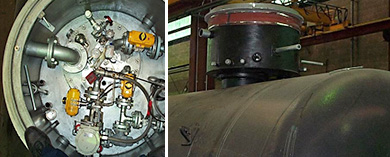
- (03) 5909 8218
- enquiry@fusionweld.com.au
Static Pressure Vessels and their Applications
March 9, 2015

The infrastructure of a processing plant is tested by many engineering factors, by fluid dynamics and chemical toxicity, by the physics of pressurized substances and the heat of flashing gases. Each hazardous component must be accounted for and incorporated into design calculations when modelling the safe and efficient flow of a particular volatile substance. This management ethic includes the dynamic load conditions in an oil refinery and the slightly more sedate but no less hazardous confines of a gas storage facility. Consider the place of static pressure vessels in any of these scenarios, the key function of these solidly fabricated containers. A static pressure vessel harnesses linear-based design methodologies, targeting superior weld technology and high-end alloys to ensure the even distribution of gases and liquids.
We've clinched the laypersons definition, but what of the engineering characteristics and applications of the vessel? We assign the moniker static to the vessels because the welded bodies of the hollow containers are built to handle linear loads. But more than this, an overhead value is incorporated in the design, thus ensuring a safety factor is in place when storing potentially explosive substances in a pressurized state. The intent is to take gaseous matter that normally occupies a far larger volume and dictate the space where that substance will be contained, confining the condensed matter within the vessel. Ideally, the location of the container is somewhere within a chemical processing plant or an oil refinery but numerous other storage and processing frameworks exist as far as this static storage model goes.
Returning to the matter of pressurized storage within a static environment, dominion over key characteristics of stored content is also managed by maintaining the static pressure vectors of the condensed fluid. The design of the vessel focuses on the elimination of any weak spots in the fabricated material, the even rolling of the ferrous or non-ferrous casing, and the careful management of high-integrity welding practices. Not surprisingly, the end result is an interior surface with an engineered bias toward the even distribution of pressurized content.
Keeping condensed stored gases and liquids at a standardized safety value and a handily reduced volume for extended period targets the design squarely at the storage of volatile matter. Oil and gas refineries use acres of static storage containers, arranging them in rows and columns to hold end-stage products before shipping or pumping the fuel out to its final destination. But here's a second application of note, the use of static storage vessels in cryogenics when storing liquid oxygen, nitrogen, and other cryogenic gases. In truth, vessels fabricated for static pressure containment may arise from the most basic container engineering models but there are few chambers in use today that require such exacting construction practices to ensure potential weak spots are eliminated.
Contact Details
Fusion - Weld Engineering Pty Ltd
ABN 98 068 987619
1865 Frankston Flinders Road,
Hastings, VIC 3915
Ph: (03) 5909 8218
Optimized by NetwizardSEO.com.au
Recent Posts
- Compressed Hydrogen Storage Vessels: Material Selection, Design & Australian Standards
- Welding QA/QC in Oil & Gas Pressure Vessel Fabrication – Ensuring Code Compliance
- AS1210 vs ASME VIII Pressure Vessel Code: Key Differences for Australian Projects
- Mitigating Hydrogen-Induced Cracking in Pressure Vessels: Engineering and Material Strategies
- Storage Tank Solutions Australia: Field-Erected, Prefabricated & Self-Bunded Explained
- Reducing Environmental Risks: Self-Bunded Tanks in Australian Oil & Gas Operations
- Precision in Production: How Pressure Vessels Are Manufactured for Industrial Safety
- Shell & Tube Heat Exchangers: Improve Thermal Control & Energy Recovery in Petrochemical & Pharmaceutical Plants
- In-Service Inspection for Compressed Air Receivers for Power Plant Shutdown Prevention
- Power Plant Pipe Spooling Fabrication – Get Rapid, Code-Compliant Spools Ready for Installation
- Field Erected Tanks: Safe, Reliable On-Site Fuel Storage Solutions in Australia
- Custom Pressure Vessel Fabrication for Flammable Gases
Posts 2025
- Compressed Hydrogen Storage Vessels: Material Selection, Design & Australian Standards
- Welding QA/QC in Oil & Gas Pressure Vessel Fabrication – Ensuring Code Compliance
- View all articles…
Posts 2024
- Large Process Vessels: Optimising the Design for Maximum Efficiency [2025]
- Pressure Equipment Management System Installation: Detect Equipment Faults Early
- View all articles…
Posts 2023
- Pressure Piping System Inspection: A Gift of Safety for the Holidays
- Deaerator Inspections by Fusion-Weld Engineering and How They Reduce System Downtime
- View all articles…
Posts 2022
- How Fusion Weld Keeps Up With AS-NZS ISO 9001:2008 Standard
- Boiler Equipment Safety Inspection During the Summer Season
- View all articles…
Posts 2021
- Avoid These Factors and Practices that Contribute to Sealing Damage in Pressure Vessels
- Do's And Don'ts Of Industrial Boiler Inspection And Maintenance From Fusion-Weld
- View all articles…
Posts 2020
- What are the Risks and Hazards Involved in Pressure Vessel Equipment?
- How to Know if Your Pressure Equipment Needs Repair or Replacement?
- View all articles…
Posts 2019
- Factors that Contribute to Pressure Vessel Failure
- Pressure Vessel Regulations in Australia: What are the Mandatory Requirements?
- View all articles…
Posts 2018
- Pros and Cons of Spherical vs. Cylindrical Pressure Vessels
- What are the Different Hazard Levels in Pressure Vessels?
- View all articles…
Posts 2017
- Transportable Pressure Vessels: The Importance of Inspection and Safety Checks
- Fracture Mechanics and Stress Analysis of Cracks in Pressure Vessels
- View all articles…
Posts 2016
Posts 2015
- What Are Deaerators & Feedwater Vessels?
- Precautions and Safety for Compressed Air Receiver Vessels
- View all articles…
Posts 2014
- Demonstrating In-process Inspection Procedures
- Static Grounding Practices and Standards
- View all articles…